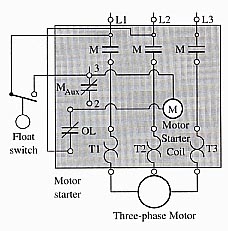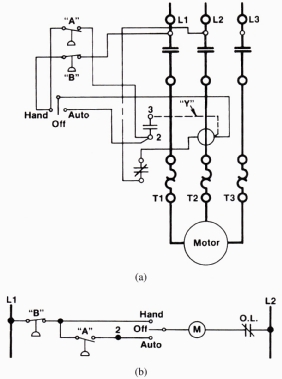
Above: Fig. 1.

Above: Fig 2.
Home
Articles
Forum
Glossary
Books
Sitemap
The two-wire control circuit is commonly used in applications where the operation of a system is automatic and basically two wires are used to provide voltage to the load. This may include such applications as sump pumps, tank pumps, electric heating, and air compressors. In these systems one typically closes a disconnect switch or circuit breaker to energize the circuit, and the actual energizing of the motor in the system is controlled by the operation of the pilot device.
The circuit is called a two-wire control because only two wires are needed to energize the motor starter coil. The circuit controls that are located prior to the coil will provide the operational and safety features, and the overload contacts that are located after the coil are used to protect the circuit against over-currents.
Figure 1 (above) shows a ladder diagram of the two-wire control circuit for a pumping station and Figure 2 (above) shows the control circuit as a wiring diagram. Note that it's difficult to see the sequence of operation in the wiring diagram, so you generally use the ladder diagram to determine the sequence of operation. The wiring diagram shows the location of all wires and components.
Voltage to the pumping station is provided through a fused disconnect. After the disconnect is closed, the float switch in the diagram is in complete control of the motor starter. Notice that the float control is identified as a float switch. When the level of the sump rises past the setpoint on the control, its contacts will energize and the motor starter coil will become energized. The coil of the motor starter will energize and pull in the motor starter contacts, which will energize the motor. As the motor operates, it will pump the liquid to reduce the level in the sump. When the level of the sump is lowered, the level switch will sense the change in level and switch its contacts off, which will de-energize the motor starter coil. When the motor starter coil is de-energized, the motor starter contacts are opened, and the motor is turned off.
This on/off sequence will continue automatically until the disconnect is switched off or unless the motor starter overloads are tripped. If the motor draws too much current when it's pumping, the heaters will trip the overload contacts and open the control circuit, which will interrupt current flow to the motor starter coil. Since the overloads must be reset manually, the circuit won't become ener gized automatically when the overload is cleared. In this case, someone must physically come to the motor starter and press the reset button. At this time, the system should be thoroughly inspected for the cause of the overload. It would also be important to use a clamp-on ammeter to determine the full-load amperage (FLA) of the motor and cross-reference this to the size of the heaters in the motor starter to see that they match. The FLA should be checked against the motor’s data plate. You should also take into account the service factor listed on the data plate when you are trying to determine if the pump motor is operating correctly.

Figure 3 (right) shows
a more complex two-wire control circuit that is used to control an air
compressor. Notice that the wiring diagram for the control and load circuit
is shown in Figure 3a and the ladder diagram of the control circuit
is shown in Figure 3b. This circuit is still a two-wire control circuit
andit's used to turn the air compressor on automatically when the pressure
drops below 30 psi and to turn off the compressor when the pressure reaches
90 psi. Pressure switch A in this circuit controls the operation of the
control at these pressures. Its high and low pressures are adjustable
so that the system could be energized and de-energized at other pressures
if the need arises. A hand switch is provided in this circuit that allows
the system to be pumped to a predetermined pressure. The hand switch
is intended to be used when the auto switch is not functioning properly
or if you need to test the system.
Right: Fig. 3 (a) A wiring diagram of a two-wire control circuit for a compressor motor. The compressor motor is controlled by a motor starter that is energized by one of two pressure switches. (b) A ladder diagram of the same circuit shown in the wiring diagram. In this circuit notice a selector switch pro vides “hand” or “auto” control. Pressure switch A is in the circuit when the selector switch is in auto, and pressure switch B is in the circuit when the selector switch is in manual.
Pressure switch B in this diagram acts as a safety for this circuit. This pressure switch is set at 120 psi and is not adjustable. It's in the circuit to prevent the tank pressure from rising too high. This could occur if the operational pressure switch became faulty and would not open when the pressure reached 90 psi. It could also be used to protect the system against overpressure when the switch is in the hand position. Generally, the safety switch is meant to protect the system against component failure or control failure.
If a pressure control would fail, the compressor would continue pumping air into the tank, which would allow its pressure to rise to an unsafe level. Since the operational switch is still closed, the air pressure in the tank could be increased to a level where the pump would cause the motor to stall if the safety switch were not in the circuit. This could build up pressure to several hundred pounds, which could cause lines and fittings in the air system to explode.
The nonadjustable pressure switch would act as a backup to the operational switch and trip off anytime the pressure reaches 120 psi. This switch is also different in thatit's interlocked when it trips, so that it must be reset manually by having someone press the reset button. If you find the reset button activated on the safety switch, you must test the system thoroughly to determine why the operational switch did not control the circuit.
In normal operation, the motor starter would cycle the air compressor on and off to keep the pressure in the tank between the high and low setpoint that is set on the operational control. The motor starter overloads could also trip this circuit and require manual reset. This could occur if the motor was incurring overcurrent problems. The overcurrent could occur due to bad bearings or if someone physically depresses the switch. When this push button is released, the NO contacts return to their NO state.
The NO auxiliary contacts from the motor starter will close when the motor starter coil is energized. When they close they will provide an alternate path around the push-button contacts for current to get to the coil. These contacts are called seal or seal-in contacts when they are used in this manner. Sometimes the seal contacts are said to have memory, since they will maintain the last state of the push buttons in the circuit.

